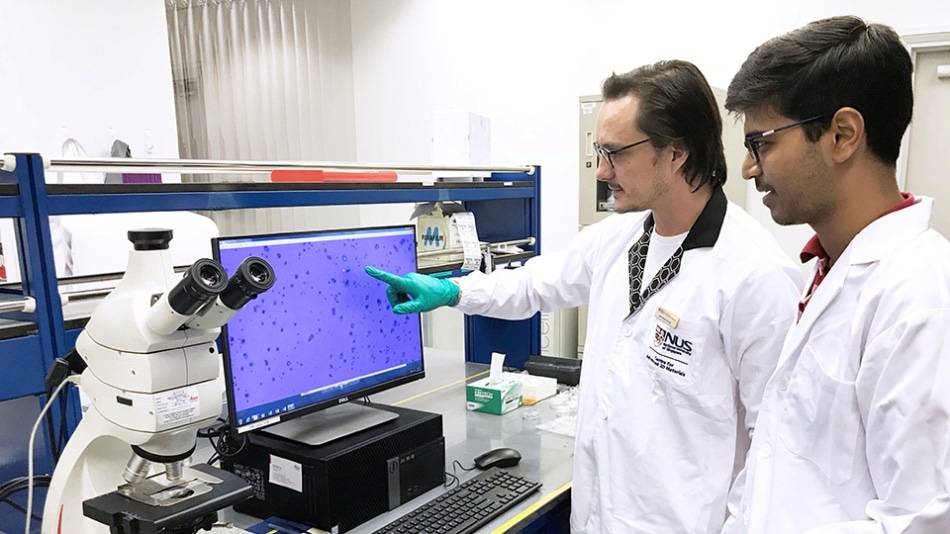Nov 14 2018
Due to a lack of quality control in commercial graphene, poor quality products are being touted as high-grade, therefore an NUS study team has come up with a reliable way to test the quality of graphene.
 Researchers from the NUS Centre for Advanced 2D Materials examining the quality of graphene samples. (Credit: NUS)
Researchers from the NUS Centre for Advanced 2D Materials examining the quality of graphene samples. (Credit: NUS)
Since graphene’s isolation in 2004, there has been a boom in graphene-connected research and development, with numerous business opportunists manufacturing graphene to make the most of this rapidly growing industry. However, National University of Singapore (NUS) researchers have exposed a huge problem—a lack of production standards has resulted in numerous cases of poor quality graphene from suppliers. Such practices can obstruct the advancement of research that relies essentially on the use of superior-quality graphene.
“It is alarming to uncover that producers are labelling black powders as graphene and selling them for top dollar, while in reality, they contain mostly cheap graphite. There is a strong need to set up stringent standards for graphene characterisation and production to create a healthy and reliable graphene market worldwide,” said Professor Antonio Castro Neto, Director of the NUS Centre for Advanced 2D Materials, who led the research.
The research results have been published in the journal Advanced Materials on September 13th, 2018.
How to tell a graphene flake from a graphene fake
Graphene has been tilted as the miracle material of the future because of its extraordinary properties. Although it is the thinnest material on Earth, it is 200 times stronger than steel. Measuring just one atom thick, it is also an unbelievable electrical conductor, but remains flexible, light, and is transparent. Thus, graphene is finding potential applications in numerous products from transistors to biomedical devices, and has even been suggested as a material for the construction of an elevator to space.
Graphene is usually made by exfoliating graphite, which can be seen in common pencil leads, into a powder, submerging this powder into a liquid, and then separating the smallest possible graphene flakes by using sound energy to vibrate the mixture. The goal of this synthesis is to create the thinnest graphene possible. Pure graphene would measure just one atomic layer in thickness; however, the International Organization for Standardization (ISO) states that stacks of graphene flakes up to ten layers thick can still act like graphene.
Keeping that in mind, Prof Castro Neto and his team started out to create a systematic and dependable method for confirming the quality of graphene samples from various parts of the world. They were able to accomplish this by using a broad range of analytical methods and tested samples from a number of suppliers.
Upon examining samples from more than 60 different providers from the Americas, Europe, and Asia, the NUS team learned that the majority had less than 10% of what can be said to be graphene flakes. The bulk of the samples was graphite powder that was not exfoliated appropriately.
Whether producers of the counterfeit graphene are aware of the poor quality is unclear. Regardless, the lack of standards for graphene production gives rise to bad quality of the material sold in the open market. This has been stalling the development of the future applications.
Antonio Castro Neto, Professor and Director, NUS Centre for Advanced 2D Materials.
Graphite powder and graphene possess significantly different properties, so any research done under the pretext that the sample was pure graphene would give erroneous results. Furthermore, just one of the samples tested in the research had over 40% of high-quality graphene. Also, some samples had been even tainted with other chemicals used in the manufacturing process. These findings mean that scientists could be wasting precious time and money executing experiments on a product that is misleadingly advertised.
“This is the first-ever study to analyse statistically the world production of graphene flakes. Considering the important challenges related to health, climate, and sustainability that graphene may be able to solve, it is crucial that research is not hindered in this way,” explained Prof Castro Neto.
Overcoming the barrier to graphene innovation
With this finding and the development of a dependable testing procedure, graphene samples may hereon be held to a higher standard.
We hope that our results will speed up the process of standardisation of graphene within ISO as there is a huge market need for that. This will urge graphene producers worldwide to improve their methods to produce a better, properly characterised product that could help to develop real-world applications.
Antonio Castro Neto, Professor and Director, NUS Centre for Advanced 2D Materials.
Furthermore, testing graphene using a universal and standardized way could guarantee easy quantitative comparisons between data generated from various laboratories and users globally.